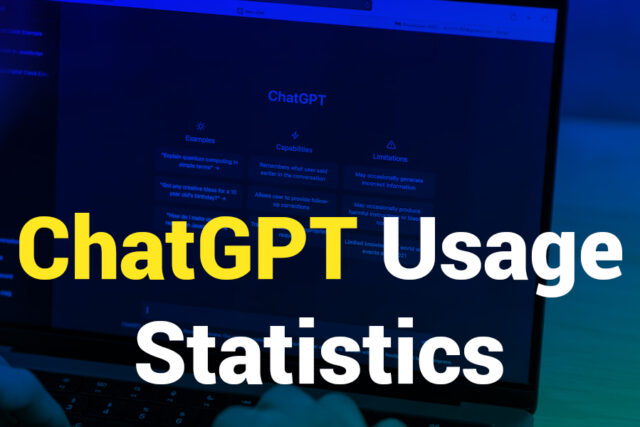ChatGPT usage statistics provide a fascinating insight into how artificial intelligence (AI) is shaping modern communication, productivity, and innovation. Since its launch, ChatGPT has been rapidly adopted by individuals and organizations, transforming how people approach creative writing, customer service, and research. But just how extensively is ChatGPT being used? Examining ChatGPT usage statistics helps uncover trends in user engagement, industries where it thrives, and how it contributes to efficiency improvements.
AI tools like ChatGPT are no longer niche technology—millions of users now rely on them for various tasks daily. Understanding these statistics offers valuable perspectives on AI’s growing influence in both business and personal applications. In this article, we dive deep into ChatGPT’s adoption patterns, trends in usage, and key data points to answer pressing questions about its global impact.
ChatGPT usage statistics refer to data on how people and businesses interact with the AI tool. Since its launch, ChatGPT has amassed millions of users worldwide, with high engagement across industries like tech, education, and customer support. Usage statistics reveal patterns such as peak usage times, task categories (e.g., content creation, coding assistance), and overall adoption trends. These figures help illustrate the growing dependence on AI-driven solutions to boost productivity and creativity.
The Rise of ChatGPT – Analyzing Usage Trends
ChatGPT has become a revolutionary tool in AI-powered communication since its introduction. Usage statistics highlight how it has permeated various industries and transformed everyday workflows. With millions of active users globally, the tool caters to diverse needs, including content creation, coding assistance, and customer support.
One of the key trends in ChatGPT adoption is its versatility. Early usage data shows that students, businesses, and developers are some of the most engaged users. Educational institutions use it to streamline research and learning, while companies employ it to improve productivity by automating customer inquiries and generating creative marketing ideas. For software engineers, ChatGPT offers a convenient method to debug and optimize code.
Global adoption rates have been impressive. Within months of its release, ChatGPT usage surged, with peak activity during work hours when businesses rely on AI-driven support. Furthermore, survey results indicate that a growing number of users trust AI tools to improve the efficiency of repetitive tasks. Another important factor influencing growth is ChatGPT’s accessibility—available through desktop and mobile apps, it has significantly lowered barriers to entry for AI adoption.
Usage statistics also highlight certain challenges. While adoption is high, concerns related to data privacy and AI limitations have prompted ongoing debates. However, with continuous improvements in AI models, these issues are being addressed to ensure that the technology remains reliable and safe for users worldwide.
What Are the Key ChatGPT Usage Patterns Across Industries?
Education Sector
ChatGPT has become a popular tool among students and educators, revolutionizing academic activities with its wide range of applications. It offers writing assistance for essays, reports, and assignments, helping students articulate their ideas more clearly and efficiently. Additionally, it supports research by providing quick access to information, summaries, and explanations, making learning more accessible. For exam preparation, ChatGPT serves as a virtual tutor by offering practice questions, explanations, and study strategies. This combination of features enhances productivity and improves learning outcomes, making it a valuable resource in both classrooms and self-study environments. Educators have also embraced the tool to streamline lesson planning and grading.
Technology and Development
In the tech industry, developers are increasingly utilizing ChatGPT to improve productivity and efficiency. The tool assists with coding tasks by generating code snippets, providing debugging support, and offering suggestions for optimization. This reduces the time spent on repetitive coding processes, allowing developers to focus on more complex tasks. Additionally, ChatGPT serves as a collaborative tool, aiding in brainstorming sessions and solving technical challenges by providing alternative solutions and new perspectives. Its versatility in handling multiple programming languages and frameworks has made it a reliable resource for developers looking to streamline their workflow.
Customer Support
Many businesses have integrated ChatGPT into their customer support operations to enhance service efficiency. ChatGPT automates responses to common inquiries, significantly reducing the workload for human agents. By handling frequently asked questions and simple requests, it frees up staff to focus on more complex customer issues. This automation improves response times and allows businesses to provide 24/7 support across various communication channels, including websites, chat apps, and social media platforms. The result is a more streamlined and scalable customer service experience, which enhances both customer satisfaction and operational efficiency.
Marketing and Content Creation
Marketing teams leverage ChatGPT to generate creative and engaging content for various platforms. Whether it’s crafting social media posts, product descriptions, or campaign ideas, ChatGPT enhances the speed and quality of content production. By automating copywriting tasks, teams can focus on higher-level strategy and creative development. Additionally, ChatGPT’s ability to generate fresh ideas supports brainstorming sessions, leading to more dynamic and innovative marketing campaigns. This helps businesses stay competitive in a fast-paced digital landscape where content is key to audience engagement.
Healthcare and Research
In the healthcare sector, ChatGPT plays a supportive role by simplifying data analysis and improving communication with patients. It helps professionals review large volumes of medical records and reports quickly, making data processing more efficient. Additionally, healthcare providers use ChatGPT to enhance patient engagement by streamlining tasks such as appointment scheduling, answering FAQs, and providing health-related information. This automation improves the overall patient experience while allowing medical staff to dedicate more time to direct patient care. By integrating ChatGPT into their workflows, healthcare organizations can improve both administrative efficiency and the quality of service.
How Many Users Rely on ChatGPT? Key Data Points
ChatGPT’s rapid growth and widespread use demonstrate its impact across industries and regions. Here are some essential statistics that illustrate its success:
- Active Users: ChatGPT attracted millions of active users within the first few months of its launch. Its intuitive functionality and versatility quickly made it a popular tool across various fields.
- Daily Interactions: The platform handles millions of requests daily. These interactions cover a range of tasks, including writing assistance, coding support, research queries, and customer service automation.
- Global Reach: ChatGPT’s user base spans multiple countries, with particularly high engagement in tech-driven regions like North America and Europe. Its accessibility and ability to support multiple languages have contributed to its global adoption.
- Industry Engagement: Several industries have integrated ChatGPT into their operations. The most active sectors include education, where it supports students and educators, technology, where developers use it for coding tasks, marketing for content creation, and customer service for automated support.
- Peak Usage Times: ChatGPT experiences peak activity during business hours, as companies and professionals rely on the tool to streamline their workflows. This pattern reflects its importance in day-to-day operations, particularly in productivity-driven environments.
- User Feedback and Satisfaction: Surveys and user feedback indicate high satisfaction rates with ChatGPT’s performance. Many users report that the tool has significantly improved their efficiency by automating repetitive tasks and providing timely assistance for complex queries. Its ease of use and adaptability to different industries have been key drivers of positive feedback.
Why Are ChatGPT Usage Statistics Important?
Analyzing ChatGPT usage statistics provides valuable insights into the tool’s impact on productivity, innovation, and AI development. These statistics play a key role for businesses, researchers, and policymakers as they shape strategies for future AI integration.
- Business Efficiency and Process Automation: For businesses, usage trends highlight how organizations are leveraging ChatGPT to improve operational efficiency. Automating tasks such as customer service reduces costs while maintaining high-quality support. Companies also use ChatGPT for content creation, coding assistance, and research, enhancing productivity across departments.
- Research on AI’s Role in Innovation: Researchers analyze these statistics to study how AI tools contribute to creativity, problem-solving, and decision-making in various sectors. The data helps identify which industries benefit most from AI integration and how it fosters new opportunities for innovation and collaboration.
- Policy Development for AI Ethics and Data Privacy: Governments and policymakers monitor usage trends to address concerns surrounding AI ethics, data privacy, and workforce automation. As AI becomes increasingly integrated into everyday life, ensuring responsible and ethical use of AI tools has become a critical priority. Policymakers rely on data to create regulations that balance innovation with societal protection.
- AI Model Improvement and Feedback Loops: Developers at OpenAI and other organizations use these insights to continuously refine and improve AI models. Usage statistics, combined with user feedback, guide enhancements to natural language understanding, responsiveness, and platform capabilities. This iterative process ensures that AI technology evolves to better meet the needs of users.
- Shaping the Future of AI Integration: Tracking ChatGPT usage trends offers a roadmap for how AI can be further optimized and applied across industries. Understanding these patterns helps stakeholders develop more effective strategies for AI deployment, whether through improved productivity tools, ethical policies, or technological innovations.
How Businesses Are Leveraging ChatGPT Usage Trends
Enhancing Efficiency
Businesses are increasingly turning to ChatGPT to enhance efficiency by automating routine tasks. By handling repetitive activities such as data entry, query management, and report generation, AI tools free up employees to focus on more strategic and creative initiatives. ChatGPT can process large volumes of data and respond to queries in real-time, significantly speeding up operations across various industries. This improved workflow not only reduces operational costs but also boosts productivity by minimizing the time spent on mundane tasks. As a result, businesses can allocate resources more effectively and improve overall performance.
Improving Customer Experience
ChatGPT-powered AI chatbots have become a key component in enhancing the customer experience. These chatbots are capable of providing instant responses to customer inquiries, reducing response times, and ensuring round-the-clock support. Additionally, ChatGPT can generate personalized responses based on user input, which helps increase customer engagement and satisfaction. By delivering tailored solutions to customer problems, businesses build stronger relationships with their clients, fostering greater brand loyalty. This improved customer experience is a significant advantage for businesses looking to differentiate themselves in competitive markets.
Content Generation
In the realm of marketing, ChatGPT is transforming content creation by enabling teams to produce high-quality material quickly and efficiently. Whether it’s writing social media posts, product descriptions, or blog articles, AI-driven tools help streamline the content production process. ChatGPT can also assist with brainstorming, and providing creative ideas and suggestions that inspire new marketing strategies. By automating time-consuming copywriting tasks, marketing professionals can focus on refining their overall campaigns, leading to more impactful and innovative content.
Data-Driven Insights
Businesses are leveraging ChatGPT usage data to gain valuable insights into user behavior and preferences. By analyzing interaction patterns, companies can better understand how customers engage with their services and identify areas that require optimization. These data-driven insights are crucial for improving service delivery, enhancing product offerings, and tailoring business strategies to meet customer needs. This analytical approach helps organizations stay agile and responsive in a rapidly changing business environment.
Collaborative Solutions
ChatGPT also plays a significant role in fostering collaboration within teams. By providing instant answers to technical and operational questions, the AI tool supports brainstorming sessions and project management tasks. Teams can rely on ChatGPT for quick problem-solving, helping them make faster decisions and maintain momentum on key projects. This collaborative capability enhances communication and productivity, making ChatGPT a valuable resource for organizations seeking to improve teamwork and innovation.
In Closing
ChatGPT usage statistics shed light on the growing importance of AI in everyday life. From education to customer service, millions of users leverage the platform to boost productivity, streamline operations, and enhance creativity. Understanding these trends helps organizations and developers refine AI technology to meet evolving needs. As adoption rates continue to rise, ChatGPT remains at the forefront of AI-driven innovation.
FAQ’s
Q: How many people use ChatGPT daily?
A: Millions of users interact with ChatGPT daily, with tasks ranging from writing and coding to customer support.
Q: Which industries use ChatGPT the most?
A: Top industries include education, technology, customer service, marketing, and healthcare.
Q: Why are ChatGPT usage statistics important?
A: These statistics provide insights into AI adoption trends, helping businesses optimize operations and developers refine AI models.
Q: How has ChatGPT impacted productivity?
A: ChatGPT has significantly improved productivity by automating routine tasks, reducing workload, and speeding up data processing.
Q: What challenges are associated with ChatGPT adoption?
A: Common challenges include concerns about data privacy, AI limitations, and the need for responsible usage practices.














